Disclosure: Meeple Mountain received a free copy of this product in exchange for an honest, unbiased review. This review is not intended to be an endorsement.
A little glimpse into my past: Video games were a major passion of mine before I discovered the joys of board games. I doubt my story is unique—like many PC gamers back then, I was obsessed with first-person shooters. But my second love was racing games, though not the uber-realistic sims. I gravitated towards the arcadey racers, where drifting and nitro boosts flowed as freely as coins in a Mario game.
As someone who loves board games and has a soft spot for racing video games, my options are quite slim. For the past few years, the only racing board game that has truly captured my heart is HEAT: Pedal to the Metal. However, that game focuses more on hand management than delivering an authentic racing experience. Most other racing board games either lean too heavily on dice rolls or become ridiculously convoluted in their attempts to simulate the intricate details of an F1 race.
REM Racer promises to be none of these things. The track doesn’t have a grid to represent spaces on the board. Instead, you move your vehicles using template movement rulers that you would find in a miniatures wargame. That’s not a surprise, because the publisher behind this one is Corvus Belli, a Spanish company. Corvus Belli is mostly known for their miniatures wargame, Infinite, so rulers like this make sense.
Sliding Into Madness
It’s not just the movement that separates itself from other racing games. There is also a heavy use of items, similar to video games like Wipeout and Mario Kart. Mines, guns, oil slicks, flamethrowers, and other familiar hazards serve the singular purpose of sabotaging your opponents. While not an entirely original concept, the use of hostile items is an underutilized concept in racing board games.
Fortunately for both you and me, REM Racer is an extremely easy and intuitive game. Each vehicle, referred to as a “Remote”, has its own unique stats. Accuracy determines how effectively you can strike opponents with weapons, while two separate defense stats protect against the different damage types. Each Remote has 3 structure points that diminish when attacked, with 0 points resulting in an inevitable respawn. There are also 4 speeds that you can adjust at the end of your turn.
A turn is quite simple. You pick a movement template that matches your current speed and you can play equipment cards before or after your movement. What’s important here is that once you pick a movement template, you can’t change it. You need to visualize your vehicle’s movement before selecting, otherwise, you will kiss the wall.
Hitting a wall is quite common and resolving that impact is easy. You simply change your Remote’s facing however you wish. Going above speed 1? Flip the top card of the equipment deck and look at the little icon at the bottom of the card. Numerous effects can occur, ranging from rebounding off walls, taking damage, being forced to discard a random equipment card, or in the most extreme cases, instant, explosive destruction.
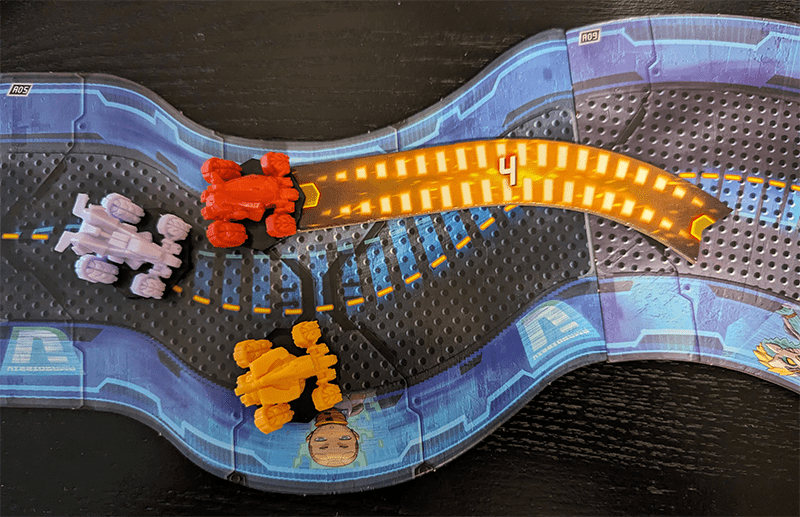
Drive-By Pain
Equipment cards are plentiful here. Each time you move into a new sector or you are in last place at the end of the round, you draw a card. These cards come in two flavors. Software cards mess with your opponent or boost yourself in some way. Weapon cards are exactly what you think they are and they involve those chunky orange dice. Roll them and compare them to your accuracy stat. For each hit, your opponent rolls them for defense to see if they deal damage or bounce off the armor. If you play miniature skirmish games, this sounds familiar to you.
In a game about racing with weapons, collisions will eventually occur. REM Racer adopts an intriguing approach here. Simply put, you don’t suffer penalties for crashing into players. The consequences are solely borne by your targets. When a collision occurs, a special template is utilized, and a die roll determines the direction in which the impacted player’s vehicle is sent careening.
In essence, REM Racers crafts a sci-fi racing experience by thrusting you into a sport where collisions are as commonplace as bullets firing across the track, with the Remotes ping-ponging off walls. I must admit, the first hour of playtime was pure, unadulterated childish glee, punctuated by flushed faces as we laughed at each other’s misfortunes. It wasn’t until the third hour that the realization dawned on us—we should have never embarked on this ride. The box clearly states a playtime of 60-90 minutes.
Childlike Joy to Existential Dread
REM Racers is one of those rare games where I found myself stopping and asking, “What the hell happened?” The presentation should indicate that this game is a success. The cover box art is a majestic example of marketing composition. The Remote miniatures are of good quality, imbued with a touch of character. Yet after playing this a few times, I’m left baffled as to how something like this could have possibly come to fruition. This somehow made it through a gauntlet of flesh and blood human beings and still reached this state.
I’ll start with the easiest one to pick apart and if you have been following me for a while, you know what I’m going to say: The rulebook is bad.
It goes far beyond my traditional complaints about vague rules. I wish that were the case. Vagueness here is replaced with contradictions and references to components that don’t exist. One easy example is the Drift Mode equipment card, which talks about Closed Turn templates. That doesn’t exist. Sharp Turns in Spanish roughly translate to Closed Turn. Fine, but there are only sharp turns for speeds 1 to 3, but not 4, so now what? Nothing in the rulebook? Alright then.
There are also the Pilot Skills. You start with a random Pilot with their own power, since board games are expected to have asymmetrical powers. It sounds reasonable until you realize one power makes a mention of a rule that doesn’t exist, and another one refutes the powers listed in the rulebook. How did this go through? Oh, are you asking me if they are balanced? Of course not, silly.
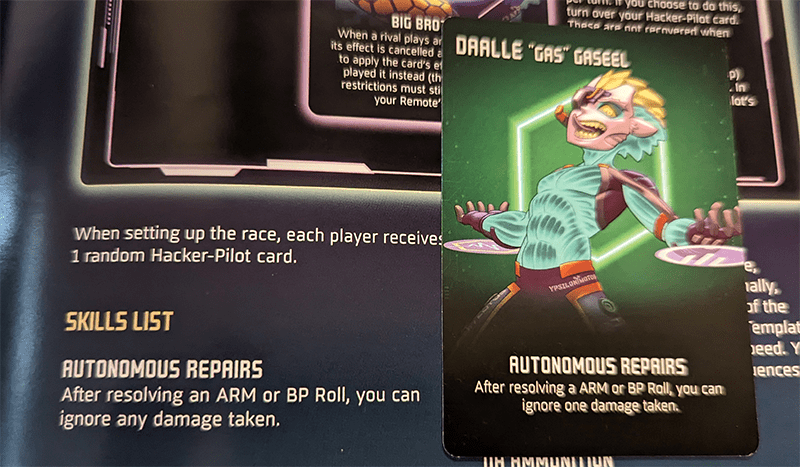
Racing Towards Regret at Ludicrous Speed
The lack of balance isn’t limited to the Pilots. Remember how I mentioned that each car has stats like accuracy and defense? Good, because some cars are simply outright better than others in numbers alone. If you like a particular color, you might be at a disadvantage. That’s not a joke.
I also must point out that the track pieces don’t interlock with each other as one would expect in these racing board games with modular pieces. The consequence of this design decision is that the board pieces are prone to sliding around haphazardly. In a game where positioning and facing play such a pivotal role, this flaw draws more unwanted attention than a boorish individual watching TikTok videos at maximum volume in a subway.
I haven’t even talked about gameplay.
There is a legitimate reason why I described the first hour of the game as joyous. It genuinely provides a solid first impression as you and your friends carve through the track, punctuated by intentional collisions and flamethrower attacks. Rivalries can easily ignite between players, with cocky individuals being met with laughter as they miscalculate angles and clever item usage taking center stage. A story unfolds, eventually consuming the entire table until it tips over the edge. It’s sincerely good stuff, at least initially.
Remotely Enjoyable
I need to give credit to equipment items as well, as not all of them are weapons. Some of the cards you get can break the rules of movement, like playing an extra movement template, a free rotation, or forcing another player to use specific movement templates for the next two turns. Honestly, I wish the game didn’t have weapons and focused only on these movement manipulations.
That becomes more apparent when the game allows you to play as many equipment cards as you like. If you happen to have a handful of weapon cards and you need to erase someone from existence, simply play all of them and roll some dice. It’s not an engaging situation at all and those 3 structure points aren’t enough for the eventual onslaught.
The biggest culprits of my frustrations are both the oil and mines. Oil templates are huge pieces of cardboard that cover an unreasonable portion of the track when deployed. Anyone who moves into there or starts their turn on a template has to resolve a collision movement with a roll of the die. You’re stuck and you might as well grab a deck of UNO cards and play “Skip Turn” on yourself.
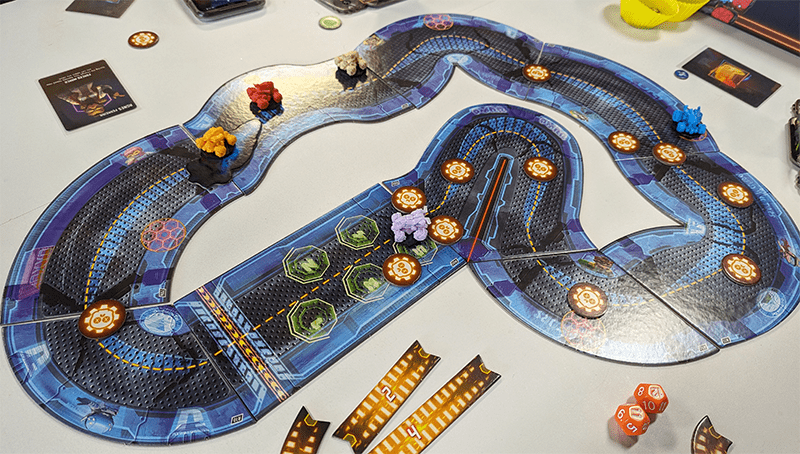
Mining For Trouble
Mines are worse. Far worse. These gargantuan discs instantaneously halt your movement and force you to roll dice to determine if you sustain two hits – more than half your health pool. This would hardly be an issue if proximity mines were a rare occurrence, except they are anything but. They are plentiful, to an absurd degree.
There are five proximity mine cards that each provide three mine tokens, and there is also a Pilot that begins with two mine tokens. Assuming you don’t shuffle the deck, that’s a staggering 17 mines. Only 14 mine tokens exist in the game. Yes, we ran out of mine tokens to place, and it’s one of the many reasons why the first game dragged on for three arduous hours.
REM Racer’s biggest problem is that it doesn’t understand how or why racing games work. Racing is all about advancing towards the finish line and your job is to progress faster than everyone else. When a racing game throws in weapons or items to attack your opponents, like in Mario Kart, it’s meant to slow people down. That doesn’t mean to stop or erase progress. REM Racer, for whatever reason, is insistent on making sure you don’t finish the game through its high-damage weapons or ridiculous mines.
REM Racers is a mess. What should have been a tight 60-90 minute race through chaos turned into a three-hour endurance test. I don’t want to play this game again.


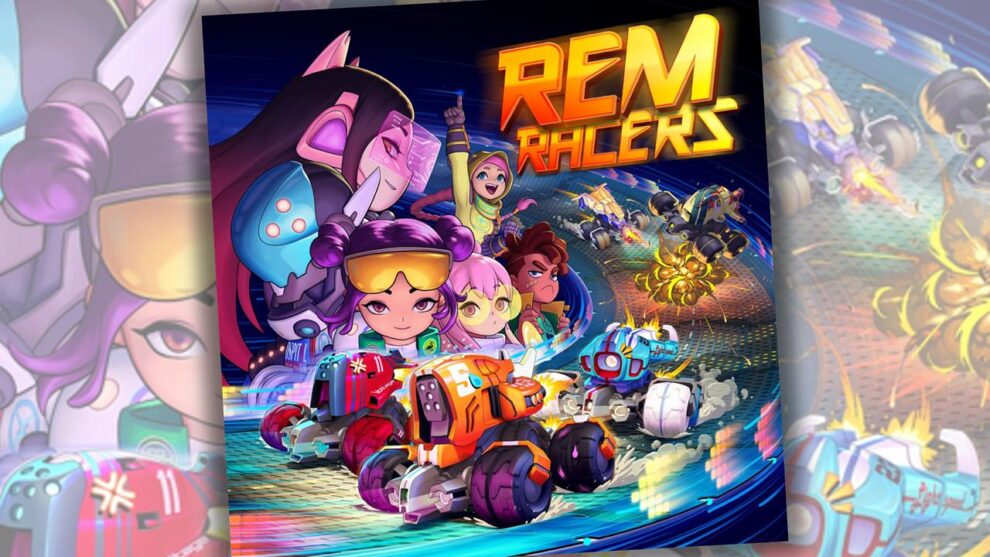

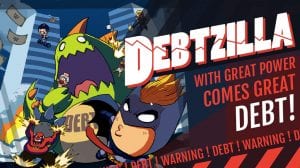

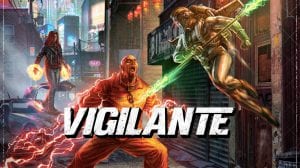




Add Comment